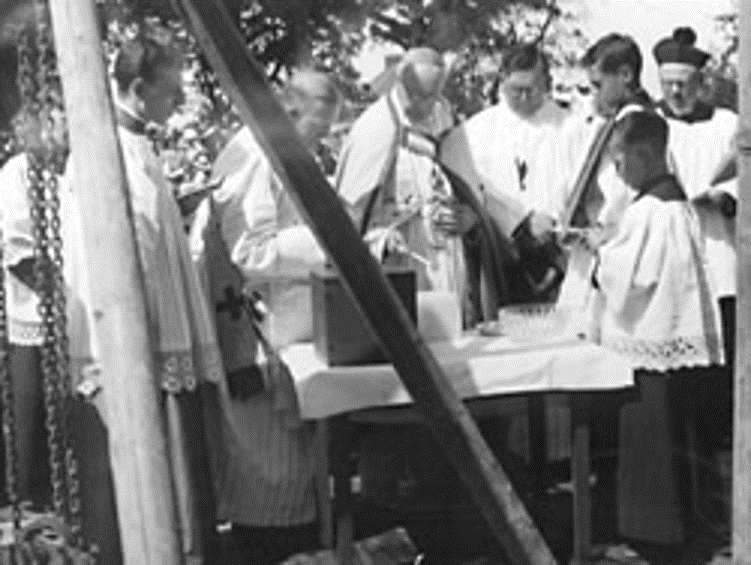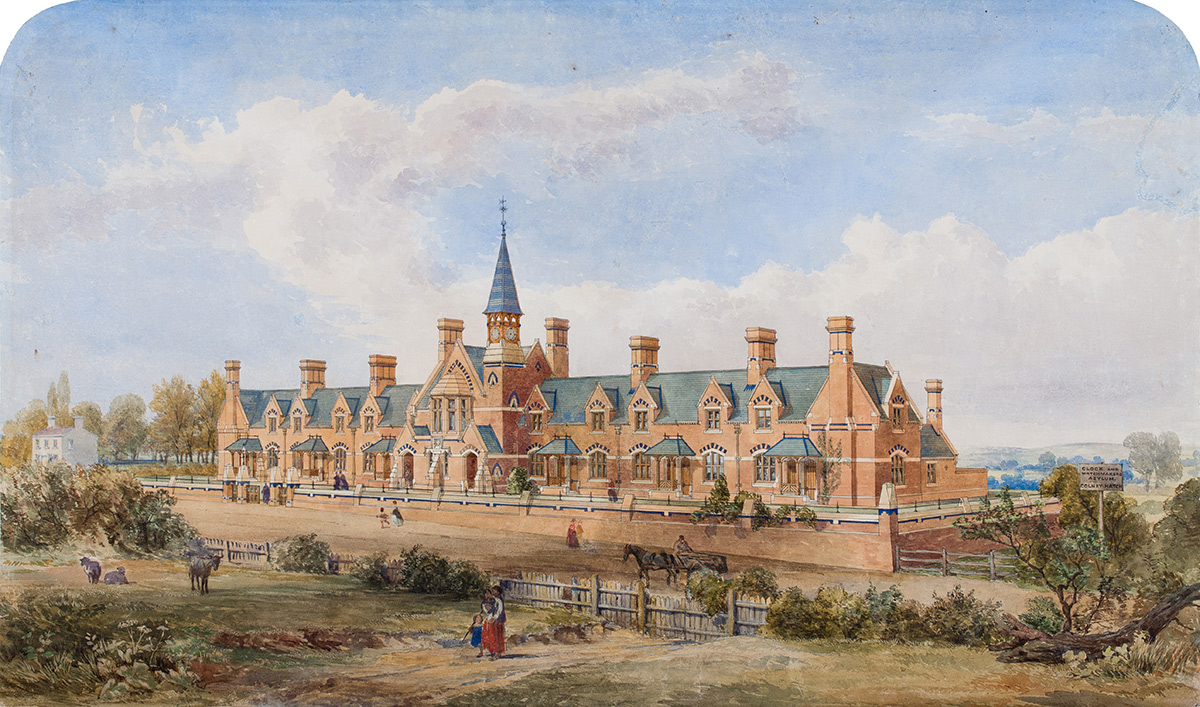Steve Coleman was a parishioner at Our Lady of Lourdes from even before the church was built. With permission from his son, Peter Coleman, here are his memoirs of the founding of the parish and local life in the first half of the 20th century.

Steve Coleman (right, holding the book) at the blessing for the building of the new church, watching his shoes disappear into the mud!
We moved in Summer 1929 to Ariluan, The Drive, N.11. a house built (solidly by Duart and Elliott) on the site of a former farmhouse and orchard. Although N.11. it was within the Wood Green parish and I went to School Mass at St. Paul’s. So did we all, except for my mother, who never relished being ‘The Headmaster’s Wife’, and finding herself now only three quarters of a mile from Our Lady of Lourdes attended there with a pleasant walk instead of a one and a half mile tram ride plus half mile walk to St. Paul's. She also vastly preferred its Austrian Parish Priest to the odd and temperamental Father Mason.
It was the custom in the post World War I Twenties to attend Sunday School (C. of E. likewise) from 2.00 to 3.00 p.m., followed by Benediction, with hymns of course, finishing about 4.00 p.m. It was an admirable institution. In days of no television and no radio, (crystal sets were just appearing for the well-to-do only!), it gave hard-worked parents two and a half to three hours of peace and quiet and an opportunity for a siesta. Children were safe on the streets in those days and could walk to and from the Church in complete safety.
So as soon as my young brother was of suitable age (7) the pair of us used to set off for not St. Paul’s but Our Lady of Lourdes, replete with the customary Sunday lunch (which we, with East End antecedents called ‘Dinner’), returning to refreshed parents in time for Tea, with toast made on long forks over the open coal fire. Our teacher was a nun from one of the many parish convents. She was so impressively effective that for many years to come I believed it to be a grievous sin to allow the Host to touch my teeth!
Because of my not going to an R.C. Grammar, I continued until I was about 13-14 years of age - with my brother Peter, of course. Besides affording the children a calming spell of inactivity in a day of leisure (for the adults a day of prayer, Mass, evening Solemn Benediction and an Act of Parliament called D.O.R.A. which prevented one from buying at the few shops open anything but sweets, tobacco and cigarettes, and essential medicines) it was an opportunity for the Parish Priest to select and train his Altar Boys.
Trained by Douglas Kempston (who in later life became a Brother in the Missionary White Fathers ) I went very nervously onto the Altar - always on Sundays in a pair. I had learned all my responses (in Latin) by heart before being permitted in the Sanctuary. This for me offered a particular difficulty in that at Trinity our Latin ‘Vs’ were pronounced ‘W’ and there were other differences from Church Latin. So I must have been 11 years old when I commenced serving.

Fr Joseph Sunn telling his plans to a local reporter.
The Parish had been established in the Diocese of Westminster in 1923. Father Sunn was the first Parish Priest. As there was no Church, Mass was said in one of the large rooms of his huge Presbytery, complete with integrated coach house, stable and hay loft (used later to garage the Priest’s car and for Parish Society meetings).
I would guess the house to be built in the Georgian period with many servants’ rooms and a separate staff staircase. With great foresight, the house was purchased with at least an acre of orchard. In modern times this provided enough space for the Church (1935) and its later extension (1990), with car park and separate entrance and exit gates and a primary school with its essential playgrounds and toilets.
Father Sunn allocated a large front reception room on the north side as his temporary church. Originally it was on the edge of open country and farmland. The suburb of N.11. grew, with quite good house-building. The old New Southgate with its 19th Century, large houses and a formerly thriving shopping centre has by road improvement been shut off from the main road, Bounds Green Road, as has also Palmers Road, my mother’s means of easy access to Father Sunn’s, as she called it.
The enlarged congregation meant enlargement of the Church Room. Father Sunn solved this by building an equivalent sized room on to it, but southwards so as not to be seen from the road, and thus not to spoil the appearance of a fine old house. Between the two rooms on the west side he added a porch and entrance door, enabling people to enter the Church without going through the front (double) doors of the Presbytery. Because of its purpose, the new room had no windows on its east and south aspects, only on its west. They commenced where the normal sashes ended and occupied the whole length of the wall.
During those early years we all received a lesson in - and accepted as entirely natural - the vagaries of health with which mankind can be afflicted. I do not know whether Father Sunn was official Chaplain to Colney Hatch; he probably was, as the next Catholic Church along the No. 21 tram line was North Finchley, at its terminus. Anyway, he permitted at the 09.15 Sunday Mass two Warders and 10-12 patients from Colney Hatch [Now Princess Park Manor, Colney Hatch was built and used as a mental hospital from 1851 to 1993, at one time housing as many as 2,500 patients.]

An 1885 illustration of what was then known as the 'Clock and Watchmakers' Asylum, Colney Hatch'.
Generally, the maladies of that Asylum’s patients ran the whole range from the simple innocuous to the violently dangerous. A Great Aunt of mine from the Parker branch of my mother’s Wheeler family had been confined there from early girlhood only because she was ‘simple’ and her mother, early widowed, had to work a full 12-hour day and was thus unable to care for her! There was no help, as today, from Social Services.
The Sunday Mass-goers were carefully selected, but the occasional epileptic fit or loud groan sufficed to make us children fearfully apprehensive (and quite delighted when something untoward occurred).
I do not remember being on the Altar during my years at St. Paul’s so I must have been selected and trained about 10-11 years. Due to my father’s ambition - not mine! - I went a year early to Grammar School and so would have then started to attend Father Sunn’s at that time. This fits in with the date of the first Mass to be celebrated in the new church, built in the Italianate style, at Easter 1935. The church would have taken one and a half years to be started and finished. Working back, the foundation stone would have been laid Autumn or Winter 1933. I had the honour of supporting the heavy Book open for Cardinal Boune to read. The M.C. was Douglas Kempston and co altar boys were Bernard McGowan and, I think, Tony Rodwell.
My memory should be alive with impressions of the Bishop’s resplendent robes and those of the assembled dignitaries, but all it retains is the horror I felt as I looked down to see my best shoes disappearing from sight in a mass of thick, squelchy yellow clay! And the foreboding of parental strictures to come on return home for Tea.

We all admired the light airy interior of the new Church. St. Paul’s, Wood Green was a dark, drab, gloomy church and I was glad to leave it.
An innovation was the ‘crying room’. The vestibule having notice boards, holy water fonts, C.T.S. pamphlets, etc. contained two huge windows through which Mass could be followed by mothers with babies and difficult infants. Fr. Sunn’s sermons were well known for stopping in mid sentence at the crying of a baby or infant!
Another innovation by Father Sunn occurred at the temporary site: the serving of a hot cup of tea and a biscuit after the two early Masses at 0815 and 0915. Normally attending 0915, once a month we received Holy Communion at the 0815. So in those days of the long all-night fast it was a benefit gratefully enjoyed.
He firmly and wisely believed that to avoid the increasing prevalence of ‘mixed’ marriages (thereby often leading to ‘lapsing’) he had to provide the means for young Catholics in particular, but also all to meet in comfort and safety socially. With the opening of the new church in 1935, the old one in the Presbytery became the Parish Hall with an available kitchen and stock room. He then held a regular series of dances, whist drives and social events which achieved his purpose. My own cousin, Molly Mullens, almost of a ‘shelf’ age, met her husband, Richard Racheil at one of Father Sunn’s whist drives.
Father Sunn also had the foresight to purchase land in the vicinity of Waterfall Lane (now Road) in the valley close to the river that runs through Arnos Park (the New River). A small fee was payable and Desmond Mullens and I spent quite a few happy summers there playing tennis at the Parish Tennis Club. It was a grass court, backed by a high brick wall boundary to the Oakleigh Road Cemetery. Against this one could practice drives and shots, particularly the backhand which was always weaker.
Father Sunn flourished till his death on 11th March 1953. The Presbytery in my years housed his aged mother; she died whilst I was in my teens. He had eventually as the Parish grew one or two notable Curates. Father Crowleigh left after many years to become Parish Priest in Hackney where I had been born. Post-War he was succeeded by Father Eldridge who had been a Padre during the War. He, although popular, was not a good accountant and I remember when he died some of the furniture in his study was found stuffed with currency notes.
Father Haughey was the longest serving Parish Priest after the War and during his time my father (and my school friend Joe Kelly) became a Founding Governor of the newly built primary school. My father when he retired aged 61 in 1948 was released from his obligation to organise the 0900 Children’s Mass at St. Paul's and was able to accompany my mother regularly at the non-Parish church.